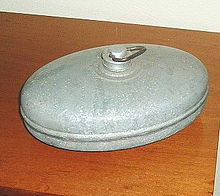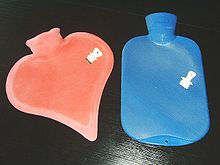- Hot water bottle
-
A hot water bottle (or hottie[1]) is a container filled with hot water and sealed with a stopper, used to provide warmth, typically whilst in bed, but also for the application of heat to a specific part of the body.
Containers for warmth in bed were in use as early as the 16th century. The earliest versions contained hot coals from the dying embers of the fire, and these bed warmers were used to warm the bed before getting into it.
Containers using hot water were soon also used, with the advantage that they could remain in the bed with the sleeper. Prior to the invention of rubber that could withstand sufficient heat, these early hot water bottles were made of a variety of materials, such as zinc, copper, glass, earthenware or wood. To prevent burning, the metal hot water flasks were wrapped in a soft cloth bag.
Contents
Rubber bottles
Modern day conventional hot water bottles are manufactured in natural rubber or PVC, to a design patented by the Croatian inventor Eduard Penkala. They are now commonly covered in fabric, often with a novelty design.
By the late 20th century, the use of hot water bottles had markedly declined around most of the world. Not only were homes better heated, but newer items such as electric blankets were competing with hot water bottles as a source of night-time heat.
Hot water bottles remain as a popular alternative, however, in the United Kingdom and developing countries and rural areas (for example, it is widely used in Chile, where it is called a "guatero"). There has been a recent surge in popularity in Japan where it is seen as an ecologically friendly and thrifty way to keep warm.[1]
Some newer products function like the older bottles, but use water soaked into a nonwoven material pad. These pads can be heated in a microwave oven, and they are marketed as cheaper and safer than liquid-filled bottles or electrical devices.
While generally used for keeping warm, conventional hot water bottles can be used to some effect for the local application of heat as a medical treatment, for example for pain relief; but here also, newer items such as purpose-designed heating pads are now often used.
Problems
There have been problems with premature failure of rubber hot water bottles due to faulty manufacture. The rubber may become brittle if manufacturing is not controlled closely enough. Natural rubber filled with calcium carbonate is the most common material used, but is susceptible to oxidation at the high tmeperatures used in shaping the product. Even though the brittle cracks are not visible externally, the bottle can fracture suddenly after filling with hot water, and can scald the user.
See also
References
- ^ a b Lewis, Leo (November 29, 2008). "Japan's thrifty find the hot water bottle to survive the chill". The Times. http://www.timesonline.co.uk/tol/news/world/asia/article5254354.ece.
External links
Categories:- Bedding
- Containers
- Medical equipment
- Medical treatments
- Heating
Wikimedia Foundation. 2010.


